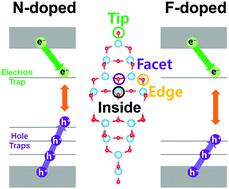当前位置:
X-MOL 学术
›
J. Mater. Chem. C
›
论文详情
Our official English website, www.x-mol.net, welcomes your feedback! (Note: you will need to create a separate account there.)
Site-dependent photoinduced charge carrier dynamics in nitrogen/fluorine doped TiO2 nanoparticles
Journal of Materials Chemistry C ( IF 6.4 ) Pub Date : 2021-1-5 , DOI: 10.1039/d0tc05063f Yeonsig Nam 1, 2, 3, 4 , Hao Li 1, 2, 3, 4 , Jin Yong Lee 1, 2, 3, 4
Journal of Materials Chemistry C ( IF 6.4 ) Pub Date : 2021-1-5 , DOI: 10.1039/d0tc05063f Yeonsig Nam 1, 2, 3, 4 , Hao Li 1, 2, 3, 4 , Jin Yong Lee 1, 2, 3, 4
Affiliation

|
Nitrogen/fluorine doping of TiO2 nanoparticles (NPs) serves to play an important role with regard to visible light absorption and charge carrier dynamics. However, it is largely unknown how nitrogen/fluorine doping retards electron–hole recombination. We carried out density functional theory and nonadiabatic molecular dynamics to demonstrate that the dopant levels, formation energies, and charge carrier dynamics depend strongly on the doping site. N-doping introduces both a hole and an electron trap without the presence of oxygen vacancies, while F-doping introduces only an electron trap. Quantum dynamics simulations show that holes are trapped within several picoseconds; N-doped NPs requires longer hole-trapping time than F-doped NPs due to the presence of an extra hole trap originating from the N 2p state. Electrons are trapped at a longer time scale than holes. F-doped NPs required longer electron-trapping time due to more strongly localized electron densities than N-doped TiO2 NPs. In general, Nitrogen and fluorine doping suppressed electron–hole recombination compared to pristine NP. NPs doped at the tip domain showed different charge recombination pathways by passing several hole traps (N-doping) or by dual channel routes (F-doping). NPs doped at edge domains showed relatively shorter excited state lifetime due to greater electronic coupling between trapped holes and electrons. NPs with doping at the inside domain effectively suppressed charge recombination due to a moderate energy gap and a reduced propensity to electron/hole localization. The diverse charge recombination scenarios revealed by nonadiabatic molecular dynamics simulations provided guidelines for the rational design of nanoscale metal oxides for solar energy harvesting and utilization.
中文翻译:

氮/氟掺杂的TiO2纳米粒子中的位点依赖性光诱导电荷载流子动力学
TiO 2的氮/氟掺杂纳米颗粒(NPs)在可见光吸收和载流子动力学方面起着重要作用。然而,很大程度上未知的是氮/氟掺杂如何阻碍电子-空穴复合。我们进行了密度泛函理论和非绝热分子动力学,以证明掺杂剂水平,形成能和电荷载流子动力学强烈依赖于掺杂位点。N掺杂同时引入空穴和电子陷阱,而没有氧空位,而F掺杂仅引入电子陷阱。量子动力学模拟表明,空穴在几皮秒内被捕获;由于存在源自N 2p状态的额外空穴陷阱,因此N掺杂的NP比F掺杂的NP需要更长的空穴捕获时间。电子比空穴的捕获时间更长。2个NP。通常,与原始NP相比,氮和氟掺杂可抑制电子-空穴复合。在尖端区域掺杂的NPs通过多个空穴陷阱(N掺杂)或通过双通道路线(F掺杂)显示出不同的电荷重组途径。掺杂在边缘域的NPs表现出相对较短的激发态寿命,这是由于陷阱和电子之间的电子耦合更大。内域掺杂的NP由于适度的能隙和降低的电子/空穴定位倾向而有效地抑制了电荷复合。非绝热分子动力学模拟揭示的多种电荷重组情况为太阳能收集和利用纳米金属氧化物的合理设计提供了指导。
更新日期:2021-01-15
中文翻译:

氮/氟掺杂的TiO2纳米粒子中的位点依赖性光诱导电荷载流子动力学
TiO 2的氮/氟掺杂纳米颗粒(NPs)在可见光吸收和载流子动力学方面起着重要作用。然而,很大程度上未知的是氮/氟掺杂如何阻碍电子-空穴复合。我们进行了密度泛函理论和非绝热分子动力学,以证明掺杂剂水平,形成能和电荷载流子动力学强烈依赖于掺杂位点。N掺杂同时引入空穴和电子陷阱,而没有氧空位,而F掺杂仅引入电子陷阱。量子动力学模拟表明,空穴在几皮秒内被捕获;由于存在源自N 2p状态的额外空穴陷阱,因此N掺杂的NP比F掺杂的NP需要更长的空穴捕获时间。电子比空穴的捕获时间更长。2个NP。通常,与原始NP相比,氮和氟掺杂可抑制电子-空穴复合。在尖端区域掺杂的NPs通过多个空穴陷阱(N掺杂)或通过双通道路线(F掺杂)显示出不同的电荷重组途径。掺杂在边缘域的NPs表现出相对较短的激发态寿命,这是由于陷阱和电子之间的电子耦合更大。内域掺杂的NP由于适度的能隙和降低的电子/空穴定位倾向而有效地抑制了电荷复合。非绝热分子动力学模拟揭示的多种电荷重组情况为太阳能收集和利用纳米金属氧化物的合理设计提供了指导。



























 京公网安备 11010802027423号
京公网安备 11010802027423号